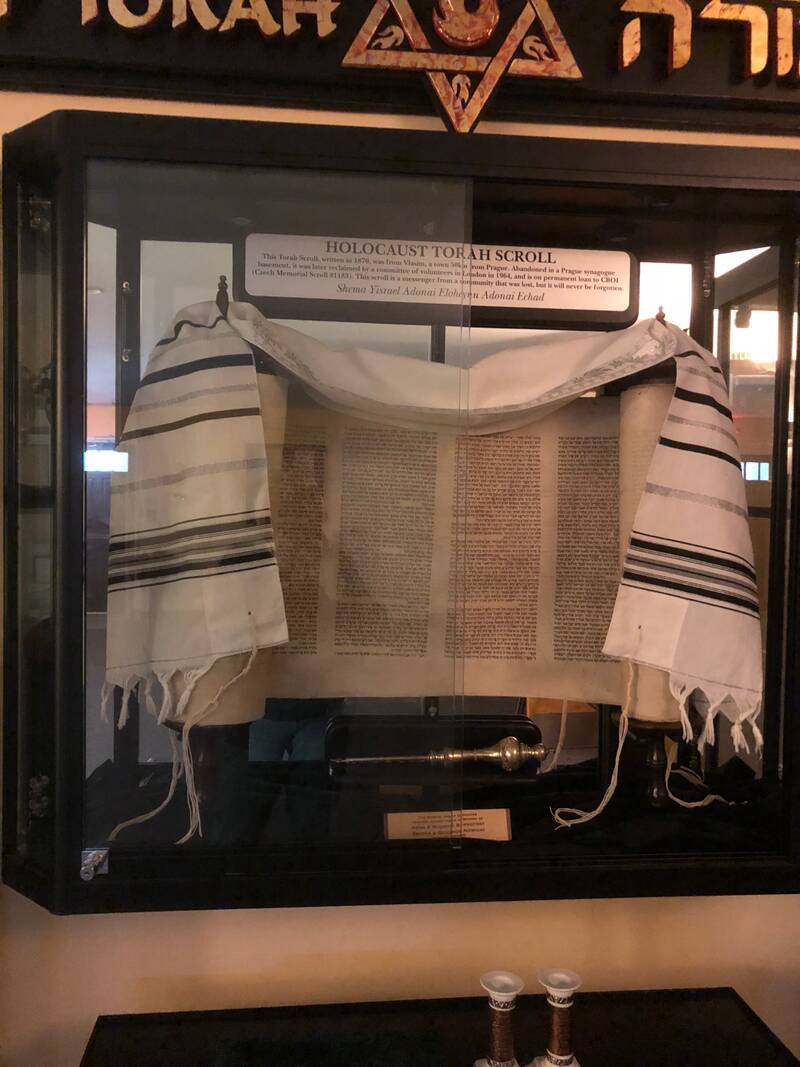
Our Scroll
The Torah is identified as MST #1183. We are honoured to showcase this scroll in a display in the lobby adjacent to the sanctuary.
The word “chai” and the number18 have great meaning. They stand for life. It is with a feeling of great justice that a large number of Torahs, torn from the synagogues of Czechoslovakia and Southern Europe, have been rescued from oblivion after 18 years in the dusty cellar of a long abandoned Prague synagogue.
The story begins in 1938 when the Nazis, seeking the valuable ornaments which adorned many of Europes most proud torahs, purged hundreds of synagogues looking for gold and silver to keep the war machine going.
The scrolls themselves were discarded, tossed carelessly into the cellar in the Czech capital. They remained there until 1963, just 18 years after the end of the war.
The Czech government, now Russian dominated, notified several other governments of their find and the news finally reached a group of English Jews centered in the Westminster Synagogue in London.
The English group brought the Torahs to London and had them refurbished by scribes that would alllow them by Jewish law to be used in synagogues around the world.
News of the find came to Bill Jaffee, a member of CBOI in 1979, who spoke several languages and worked in Army intelligence during the war. He talked it over with other congregants and Rabbi Howard Hersch and decided to ask for one of the torahs.
After months of negotiations a Torah arrived from England in March 1979. CBOI decided to fund the acquisition only through the children's Karen Ami fund. No other individual contributions were accepted because Brothers wanted the Torah to be truly be a synagogue project.
The Westminster group was reimbursed for their expenses, having had to pay the Czech government to get the Torahs out in the first place.
So the Torah came to CBOI in Trenton and resided in the Aron Kodesh in the sanctuary. It was dedicated on Yom Kippur.
It took 18 years to find them, but the torahs still live and will bear out the word “Torah” itself…to teach.
Rabbi Hersch said “This Torah will be a living thing. Every year when we say Yizkor, every year when we observe Yom Hashoa, every year for Simchas Torah, we will look to this Torah and know the immortality of the Jewish people.”
One of the Torah scrolls in our synagogue has rather special significance. It originates from the community of Vlašim, a town in the Central Bohemian Region of the Czech Republic, 70km south-east of Prague. Vlašim has around 11,500 inhabitants and is situated on the Blanice river. In 1893 the town’s Jewish population was 210; we know that in 1921 there were still 87 Jews in Vlašim. By 1930 the Jewish population had dropped to 67 (of a total population of 3,625). On December 11, 1942, Vlašim’s 63 remaining Jews were deported to Terezín together with the Jews of Prague. We know the names of those people; they have been etched into the stone at the synagogue in Prague. From Terezín most were sent to the death camps of Poland. Only four of them survived.Today Vlašim is known for its castle and English style park with many pieces of romantic architecture such as the Chinese pavilion, Old Castle and its three gates.
The scroll is on loan in perpetuity from the Memorial Scrolls Trust.
Memorial Scrolls Trust
In 1942 a devoted group of eight Jewish historians and communal leaders devised a way to bring the religious treasures from the deserted communities and destroyed synagogues in Czechoslovakia to the comparative safety of what had become the Central Jewish Museum in Prague. The curators laboured under appalling conditions to preserve these holy objects that had previously been at the mercy of vandals and plunderers. Each one was meticulously recorded, labelled and entered on a card index by the Museum’s staff with a description of its origin. The curators hoped that these treasures would be protected and might one day be returned to their original homes. All of the museum’s curators were eventually transported to Theresienstadt and Auschwitz, with only two survivors.
After the war, with fewer than 8,000 Czech Jews having survived (from a population of more than 100,000 before the war) the objects remained warehoused in an unused synagogue. The surviving remnant of the Prague Jewish community lacked the resources to maintain the museum, so it came under the control of the Czech state authorities. The 1,564 Torah scrolls in the collection could not effectively be displayed as museum exhibits, and they would eventually deteriorate if they remained rolled up and unused. In 1963, Ralph Yablon purchased the scrolls and entrusted them to Westminster Synagogue, which in turn distributed the scrolls to various synagogues, educational institutions, and other bodies wishing to have a memorial to the communities destroyed in the Shoah.
There are no Jews in Vlašim today but other scrolls from there are at Mishkan Torah Synagogue of Greenbelt, Maryland, Temple Judea of Palm Beach Gardens and Temple David of Mount Lawley, Western Australia. All our communities are linked with each other and to the martyred community of Vlašim. In the words of Rabbi Jonathan Cohen of Mishkan Torah Synagogue:
We carry on for them. May we be worthy of perpetuating their memory in the way by which we honour their most sacred possession and live its lessons.


